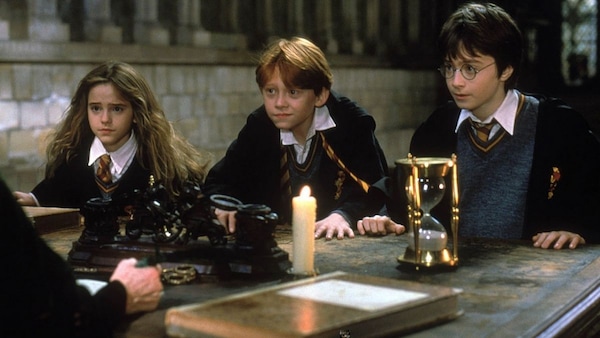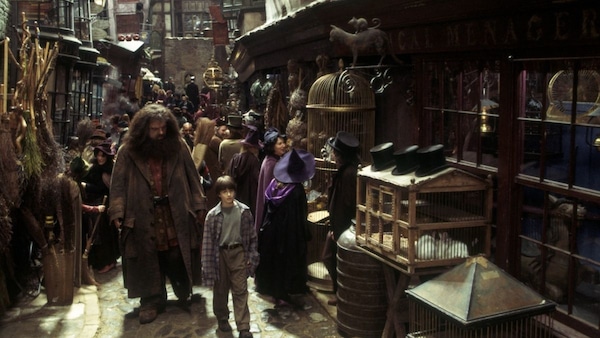Harry Potter and the Philosopher’s Stone: 20 years since release, Chris Columbus’ film remains as enchanting as before
Chris Columbus crafted a world that was as fantastical as it was rooted in reality.

Last Updated: 08.10 PM, Nov 16, 2021
Harry Potter and the Philosopher’s Stone (HPATPS), the first instalment of the Harry Potter movie franchise, kickstarted what was to become the defining pop culture phenomenon for the noughts, comfortably sandwiched between the 90s Star Wars mania and the post-2008 Marvel fandom.
Arriving four years after the release of the book in 1997, HPATPS birthed a generation of readers who would previously shy away from venturing into novels. Harry Potter opened up an fascinating world of limitless possibilities for young viewers, in which wizards and witches, flying cars, headless ghosts and three-headed-dogs triumphantly coexist. HPATPS was a sensory explosion — and it effectively changed how children’s movies were perceived to be in later years.
Beyond the spectacle though, Harry Potter is a coming-of-age story about three endearing 11-year-old protagonists navigating as many supernatural threats as real-world ones — be it two-headed professors or middle school identity crisis. They are the quintessential underdogs who lead simple lives until they are thrust into a world of magic. The masterstroke, however, was casting the angelic Daniel Radcliffe, Emma Watson and Rupert Grint in the roles of Harry Potter, Hermione Granger and Rupert Grint, respectively. The three embody the wide-eyed innocence and pre-teen butch spirit that children resonated with, and adult audiences felt nostalgic about.

Almost a third of the movie serves as a prologue to Harry Potter’s awful life inside a cupboard under the stairs in the Dursley household. Orphaned as an infant, Potter is forced to live with his abusive relatives — Uncle Vernon (Richard Griffiths), Aunt Petunia (Fiona Shaw) and Cousin Dudley (Harry Melling)— until he is whisked off by Hogwards’ groundskeeper Rubeus Hagrid (Robbie Coltrane) to a place where nothing seemed impossible. Here, bricks readjust themselves to reveal the way to Diagon Alley, banks are operated by goblins, chocolate frogs leap out of cardboard boxes, and broken glasses are fixed with simple spells like Oculus Reparo. He is Dickensian Oliver Twist in the tale, who soaks up the charms and wonders of the wizarding world with a frenetic enthusiasm. Thus, his stepping into a world of magic becomes an extended metaphor for him leaving behind a life of abject isolation to enter a space where he can finally belong. No matter how many times one watches the scene, Harry’s awe at creaky old buildings cascading over one another still feels mint-fresh.

The introductory shot of the majestic castle of Hogwarts School of Witchcraft and Wizardry was haunting and epic. By the time the students sail into the campus, the night has fallen.
For these students, the atmosphere is as intriguing as it is exciting. The slate grey sky choked in fog is mirrored in the turbulent waves crashing against the Gothic-inspired structure with buttresses, towers and turrets sneaking out of its silhouette into the night sky. John William’s rousing score almost underscored the magnanimity of the castle. The composition titled Hedwig’s Theme, that plays in the background of this scene, later is used at the leitmotif across all the eight films, harking viewers back to the epicentre of the world.
Chris Columbus’ attempt at recreating JK Rowling’s intricately mystical world is regarded to be largely faithful to the source material. This means that HPATPS was heavily dependent on visual effects. The first film has impressive CGI for its time, evidenced especially in the scene where Ron, Harry and Hermione partake in a wizarding chess game with larger-than-life pieces that move by themselves and attack human players with real weapons. This scene is perhaps one of the most well-choreographed action sequences in the history of children's movies. The stakes are high, sure, but it is the only film in the series that does not veer into the disturbing or dark territories. It is almost like Chris Columbus and JK Rowling ease their viewers into this world before unleashing it in its fullest capacity. HPATPS effectively captured the essence of the novel by striking a balance between scary, but so much as to alienate its target audience.

However, a particular scene from the movie that hasn’t quite aged well is the first-ever Quidditch match. The scenes were arguably difficult to translate on screen, since the VFX team had to create the match pitch, the surrounding scenery and then integrate the human characters flying around in brooms inside the setting. In retrospect, the match does look positively green-screen heavy and less-than-perfectly executed.
HPATPS at 20 is not just ubiquitous for the nostalgia of millennial childhood. It’s also a crude reminder of the fact that magic does not exist outside of writer’s quills. That mortality is the only constant. Thus, we’ve had to make peace with the deaths of Richard Harris, Alan Rickman, Richard Griffiths and John Hurt, who play the characters of Dumbledore, Snape, Uncle Vernon and Mr Ollivander, respectively.
With the recent reckoning around JK Rowling’s transphobic statements, there has been a dip in the popularity of the books and movies, but there is nothing that can replace the pure ecstasy of experiencing, almost first-hand, the beauty and terror of magic.
